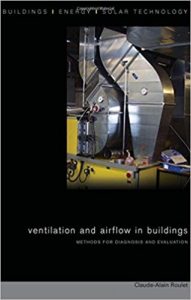Ventilation and Airflow in Buildings Methods for Diagnosis and Evaluation
Ventilation and Airflow in Buildings Methods for Diagnosis and Evaluation
Ventilation and Airflow in Buildings Methods for Diagnosis and Evaluation,Without ventilation, a building’s occupants will initially be troubled by odours and other possible contaminants and heat. Humidity may rise because of indoor moisture sources such as the occupants, laundry, cooking also plants; thus enhancing moisture hazards (for example, mould growth also condensation). Oxygen will nevertheless not be missed until much later. The purpose of ventilation is to eliminate airborne contaminants, which are generated both by human activity and by the building itself. These are:
- Bad odours, to which people entering the room are very sensitive;
- Moisture, which increases the risk of mould growth;
- Carbon dioxide (CO2) gas, which may induce lethargy at high concentrations;
- Dust, aerosols and toxic gases resulting from human activity, as well as from the building materials (in principle, ‘clean’ materials should be chosen for internal use, but this is not always possible);
- Excessive heat.
Studies have shown that ventilation systems seldom function according to their commissioned design. They have also shown that airflow measurement results are essential in improving a ventilation system. The book will help building physicists and ventilation engineers to properly commission ventilation systems and appropriately diagnose ventilation problems throughout the life of a building. Drawing on over 20 years of experience also the results of recent international research projects, this is the definitive guide to diagnosing airflow patterns within buildings.
You can also Read Understanding Mechanical Ventilation: A Practical Handbook 2nd edition
Ventilation and Airflow in Buildings Methods for Diagnosis and Evaluation Product details
- Series: BEST (Buildings Energy and Solar Technology)
- Hardcover: 210 pages
- Publisher: Routledge (December 12, 2007)
- Language: English
- ISBN-10: 184407451X
- ISBN-13: 978-1844074518
- Product Dimensions: 6.2 x 0.8 x 9.2 inches
- Shipping Weight: 1 pounds
Ventilation and Airflow in Buildings Methods for Diagnosis and Evaluation content
- List of Figures and Tables
![Ventilation and Airflow]()
- Preamble
- Introduction
- Airflow Rates in Buildings
- Airflow Rates in Air Handling Units
- Age of Air and Ventilation Efficiency
- Airtightness
- Measurements and Measures Related to Energy Efficiency in Ventilation
- Contaminants in Air Handling Units
- Common Methods and Techniques
- References
- A: Unit Conversion Tables
- B: Glossary
- Index
Download
Ventilation and Airflow in Buildings Methods for Diagnosis and Evaluation
Ventilation and Airflow in Buildings Methods for Diagnosis and Evaluation


Comments are closed.